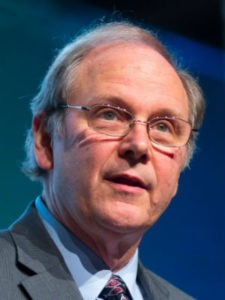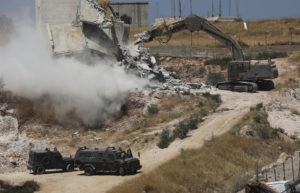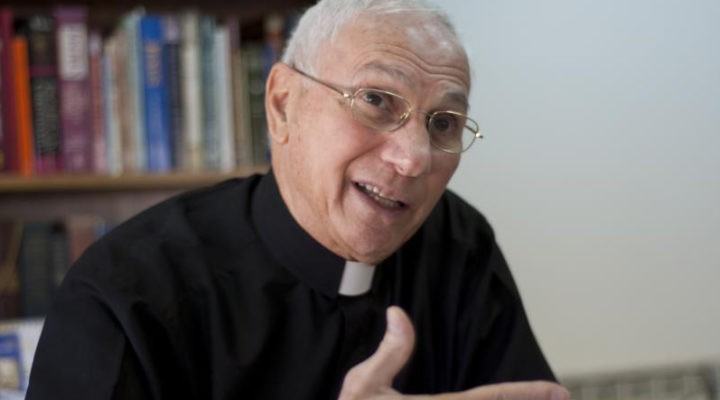As a professor of missions and theology at Logsdon Seminary for 18 years, I was committed to introducing my students to fascinating, significant people whose challenging ideas would instruct and inspire, helping to create more engaged and equipped young adult Christians and ministers.
Diana Eck from Harvard University, the most respected living world religionist in America, talked about how to be an interfaith Christian in a religiously plural world. Marc Ellis, professor of Jewish studies and prolific writer, introduced Jewish liberation theology and contemporary Judaism. Arun Gandhi, “peace farmer” and grandson of India’s great spiritual and political leader, Mahatma Gandhi, explained lessons he had learned from his grandfather that have relevance for peacemakers today. Local Hindu, Buddhist, Muslim and Baha’i guests also presented lectures in my seminars.

Robert Sellers
I led cross-cultural classes among the Navajos of the Four Corners, as well as in Mexico, Brazil, Kenya, South Africa, Great Britain, Belgium, the Netherlands, Germany, Switzerland, Austria, Italy, Poland, the Czech Republic, Macedonia, Malaysia and Indonesia. There, students spent time learning from sheepherders in Arizona, as well as environmentalists in the Amazon, anti-apartheid interracial activists in Johannesburg, holocaust survivors in Poland, Albanian Muslim and Macedonian Orthodox interfaith advocates in Skopje, and garbage collector families in the poorest of neighborhoods of Jakarta.
Yet, perhaps the most intriguing and instructive person my students ever met in my classrooms anywhere in the world was Naim Stifan Ateek.
A Christian, Palestinian, Arab, Israeli
Ateek is a 1963 graduate of Hardin-Simmons University. In 2007, the university recognized him as a distinguished alumnus, and he was brought to the campus to receive his award. To my mind, this was a courageous choice for the university — and one that perhaps would not be made at HSU currently. It was an honor, then, to become his friend and have him speak in my classes.
Naim presents himself in a fascinating way, as evidenced in this excerpt from his book, Justice and Only Justice: A Palestinian Theology of Liberation:
As a person who comes from the Middle East, I embody the different stereotyping to which my people have been subjected. Once I define or introduce myself, a number of contradictory images surface in the minds of many people. Some are curious; others are stunned … . There are four important words that, cumulatively, make up my identity: I am a Christian, a Palestinian, an Arab, and an Israeli. If I wanted to add to the confusion … I would add that I am an Episcopalian (Anglican) and a clergyman.
These terms of identification may seem puzzling. Someone might admit, “I didn’t know that Arabs could be Israeli citizens; I have thought all Israelis were Jews.” Yet, according to Israel’s Central Bureau of Statistics in 2019, almost 21% of the nation’s population were Arabs and the majority of them identified as Palestinian.
“There are at least 12 million Christians in the Middle East.”
Another person could question, “But can a Palestinian be a Christian? I have assumed all of them are Muslims.” Ateek explains that there are at least 12 million Christians in the Middle East, a number he cited in his 1989 book but that is still applicable today. Moreover, current demographic statistics reveal that about 20% of Palestine’s 13 million inhabitants are Christian.
Still another would possibly protest, “But how can a clergyman be a Palestinian? I have heard that Palestinians are terrorists.” To this question, Ateek responds:
Tragically, this is the way many people have come to perceive the Palestinians. How did this happen? Is it the result of propaganda?… Palestinians have been labeled as terrorists by the state of Israel and its friends so that Israel might seem right and justified in its actions against the Palestinians. And some Palestinians have been guilty of acts of terror … . Having said that, let me hasten to add that the huge majority of Palestinians are not terrorists, nor have they at any time advocated terrorism. Palestinians are a people who call the country of Palestine their home, the land of their ancestors. For many centuries Palestinian Muslims, Palestinian Christians, Palestinian Jews, Palestinian Druze, and, more recently, Palestinian Baha’is have lived side by side. They belonged to different religious faiths, but they were all Palestinians.
“My friend is a self-proclaimed Christian Palestinian Arab Israeli.”
So, my friend is a self-proclaimed Christian Palestinian Arab Israeli. The terms sound confusing, until one thinks of our own context, where we are familiar with Buddhist Chinese Asian Americans or Indigenous Choctaw Native Americans. Similarly, who he is should be no more mystifying.
Losing a family home
It is Ateek’s clergy identity, however, that is most interesting, for it is at the very heart of the Israeli-Palestinian conflict in which he has conducted his 55-year ministry.

Israeli forces destroy a building in a Palestinian village of Sur Baher, east Jerusalem, Monday, July 22, 2019. Israeli work crews demolished dozens of Palestinian homes in an east Jerusalem neighborhood after a years-long legal battle over the buildings, which straddle the city and the occupied West Bank. (AP Photo/Mahmoud Illean)
Naim was only 11 years old when Zionist-inspired Israelis occupied his village of Beisan. As he recalls: “We had no army to protect us. There was no battle, no resistance, no killing, we were simply taken over, occupied, on Wednesday, May 12, 1948.”
Concerning his family of origin, the 84-year-old Palestinian pastor testifies:
The good Lord blessed my father with a large family of seven girls and three boys. I was the eighth child. After work, or early in the morning, my father enjoyed tending the garden around our house … . I still have many fond memories of helping my father till, plant and irrigate the garden. My father, who was brought up as an Eastern Orthodox Christian, decided early in his life to take his faith seriously. Our house was a center of Christian activity, Bible study and Sunday school. On Sundays the family would go to the Orthodox church for the liturgy, and the congregation would then send their children to Sunday school in our house and would themselves attend Bible study there … . (My father) was later instrumental in founding a small Episcopal (Anglican) church in Beisan.
But on that spring morning when the family was confronted by a Civil Administration demolition officer accompanied by Zionist troops, the Haganah, young Naim’s simple, good life was disrupted forever. Fellow villagers fled from their own homes in horror, having heard that when Jewish soldiers had recently occupied the town of Deir Yasin, near Jerusalem, they had massacred 254 people — including women and children — and threw their bodies into a well.
“Absolutely helpless to stop the destruction of his home, the despondent patriarch took courage from the words of the Psalmist.”
Although Naim’s father begged the official to allow them to remain in their house, since he had nowhere else to take his large family, he was told, “If you do not leave, we will have to kill you.” Absolutely helpless to stop the destruction of his home, the despondent patriarch took courage from the words of the Psalmist: “Why are you cast down, O my soul, and why are you disquieted within me? Hope in God, for I shall again praise him, my help and my God.”
The Ateek family, like other Christian Palestinians whose land had been seized to be given to Jewish settlers, found themselves with their few hand-held possessions transported on a bus to the edge of Nazareth, where they were released as refugees, forever separated from Beisan and their ancestral home. The bitter experience scarred Naim, and had it not been for his parents and their deep faith, he surely might have been overcome by hatred and a desire for revenge.
A return to see their homeplace
Due to his father’s cleverness, the family had one final chance — almost 10 years later — to look briefly upon their beloved village and home, as Naim recounts:
On Israel’s Independence Day in 1958 the Israeli military governor had allowed the Palestinian Arabs living in Israel to move around without permits. My father took advantage of this temporary freedom to rent a pickup truck and take all of his children back for the first time to see our home in the town of Beisan, the home from which we had been forced out nine years earlier. Even today I clearly remember how we were not allowed even to look inside our home. The three houses built by my father that made up our home had been divided into smaller units, each occupied now by a Jewish immigrant family. It must have been very difficult for my father to see our home occupied by Jewish immigrants who had come from North Africa while he, the rightful owner, was prevented even from entering them. A few days after this traumatic experience, my father suffered a stroke from which he never fully recovered, leaving him unable to walk or speak clearly.
Education and ordination
Graduating from Hardin-Simmons University with a degree in chemistry, Naim studied theology at the Church Divinity School of the Pacific, an Episcopal seminary from which he received his master’s degree in 1966. Back in Israel that year, he was ordained an Anglican deacon at Christ Church in Nazareth, where he had grown up.
It was a thrilling experience albeit a bittersweet one, since his father had died in 1964 and wasn’t there to celebrate. Yet Naim felt his father with him, blessing him as he took his own sacred vows. The young minister was especially encouraged by the passage Jesus had read from the scroll of Isaiah as he stood in the Nazareth synagogue, words inscribed in Arabic above the altar before which he knelt: “The Spirit of the Lord is upon me, because he has anointed me to bring good news to the poor. He has sent me to proclaim release to the captives and recovery of sight to the blind, to let the oppressed go free.”
“Naim felt his father with him, blessing him as he took his own sacred vows.”
Seven months later, Naim was ordained a priest at St. John the Evangelist Church in Haifa. Two socio-political events greatly influenced the direction of his subsequent ministry. The first was the 1967 war between Israel and Egypt, Syria and Jordan. Israel’s preemptive strike startled its enemies and altered the map. Following that war, Israel occupied the rest of Palestine, including the West Bank, East Jerusalem, the Gaza Strip; parts of Jordan; and large territories from Egypt and Syria.
The intifada
The second event was the intifada, a revolt of the whole Palestinian community, which occurred at the end of 1987. As the Israeli oppression had become more severe while Palestinian cries for justice in the face of continued expansionist policies had gone unheeded, “Palestinians — men and women, young and old — rose up in solidarity with one another with one clear message: the illegal Israeli occupation of their country must come to an end.”
By this time, Naim was a canon, or priest, at St. George’s Anglican Cathedral in Jerusalem. Thus, as he struggled to be both relevant and redemptive, the liberation theology ideas he had been contemplating during graduate school at Berkeley began to flower. As he writes:
As soon as the intifada started, I felt that my preaching had to become more relevant to our new political context. This small Anglican congregation in Jerusalem, like the rest of the Christian community on the West Bank and in the Gaza Strip, was in need of comfort and courage. It needed to hear the word of God addressing their particular situation. Of life. If the Bible had nothing to say to them in their pain and sorrow, in the midst of injustice and oppression, then the Bible had no relevance for their lives.
But Ateek discovered it was difficult to preach peace and reconciliation in a context of continual injustice and oppression. So, he realized that “the only response had to be a prophetic response in the spirit of the great prophets of the Old Testament, on the one hand, and, on the other, in the spirit of Jesus and the New Testament.”
“Ateek discovered it was difficult to preach peace and reconciliation in a context of continual injustice and oppression.”
Describing the process that gradually unfolded, he adds:
Every week they took the sermon, chewed it and digested it. They added their own illustrations from their own experience during the previous week and that of their relatives and neighbors. They talked about the people who had been killed or injured or imprisoned … . People challenged each other, struggling with the demands of the gospel against the human tendency to respond with violence and exact revenge. They refused to dilute the gospel by lowering it to the level of hate and violence. Together we were able to hear Christ challenging us to love and not to hate. While the Israeli army was increasing its oppressive measures and Israeli soldiers were breaking the bones of Palestinian children for throwing stones, as well as humiliating and even killing them, the natural response was to give in to resentment and the desire for revenge and to be pulled down to the level of the subhuman. It was a constant challenge to our faith to resist this natural response, and to be pulled up by Christ to be the people God wants us to be. It was there that the Palestinian theology of liberation in its early stages began to be applied and tested.
By the end of 1993, Naim took what was happening in the cathedral and started an ecumenical Christian organization that applies a theological basis for freedom and justice in a context of occupation and injustice. The name “Sabeel” was chosen, which is the Arabic word for “the way” or “the spring.” It was the perfect name for an Orthodox, Catholic, Anglican and Protestant partnership that was seeking to follow the nonviolent, peaceful way of Jesus Christ and promising a season of growth and rebirth.
For Sabeel, understanding Jesus as a Palestinian who also lived under foreign occupation and was thus a paradigm of liberation is the key to connecting with the lives of Palestinian Christians. Ateek clarifies: “All his travels, his eating and drinking, his teaching and healing ministry, his relationships with others … were carried out under the oppressive domination of the Romans. Finally, he was executed by the occupation forces in collusion with the religious leaders of first-century Jerusalem.”
And, as followers of Jesus and as a Christian movement, Sabeel believes it cannot condone or practice violence. It must exist and behave as an alternative to the actions of Hamas or any other violent response to Israeli oppression.
Think beyond stereotypes
The Israeli-Palestinian conflict has a long and brutal history. Despair, destruction and death have been experienced by people on both sides of the wall. You may not regard the problem nor imagine the solution in the same way I do. Nonetheless, my hope is that you will not think in stereotypical fashion about God’s children from either camp. Not all Israelis are Zionist occupiers. Not all Palestinians are Hamas terrorists. The majority of both Israeli and Palestinian people are simply wanting to live their lives without fear, with their human rights protected, with opportunities not only to survive but to thrive.
As you consider the ongoing tensions in Israel — especially in Jerusalem, the West Bank and Gaza — please remember my friend Pastor Naim Stifan Ateek. He happens to feel that the only possible way through this morass is the establishment of a Palestinian state alongside the state of Israel. That may not be your viewpoint.
But do consider his summary statement about potential solutions: “I have come to believe that any genuine solution offered should pass the test of these two sayings of Jesus Christ. ‘In everything do to others as you would have them do to you, for this is the law and the prophets’ and ‘You shall love your neighbor as yourself.’”
Pray for our Christian brother in Jerusalem and for his work through Sabeel. And remember, please, this Palestinian Christian’s cry for justice.
Rob Sellers is professor of theology and missions emeritus at Hardin-Simmons University’s Logsdon Seminary in Abilene, Texas. He is a past chair of the board of the Parliament of the World’s Religions in Chicago. He and his wife, Janie, served a quarter century as missionary teachers in Indonesia. They have two children and five grandchildren.
Related articles:
Apartheid in Palestine and a Christ who stands on the other side of the wall | Analysis by Chris Conley
Trump’s Middle East peace plan makes sense until you read it, Christian peace activist says
Baptist convention denounces ‘oppression and violence’ toward Palestinians


